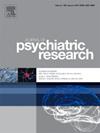精神分裂症和双相情感障碍的错配负性缺陷
IF 3.7
2区 医学
Q1 PSYCHIATRY
引用次数: 0
摘要
大量的研究表明,失配负性(MMN)缺陷存在于精神分裂症(SCZ)中,越来越多的证据表明,双相情感障碍(BPD)也存在类似的缺陷。然而,尚未对中国SCZ和BPD患者进行大规模MMN研究。本研究旨在验证SCZ患者中MMN缺陷的存在,并评估BPD患者是否表现出类似的缺陷,使用大规模的中国队列。方法收集参与者的smmn数据、rban评分及其他临床访谈和评估数据(SCZ: n = 208;BPD: n = 144;健康对照组(HC): n = 324。以年龄和性别为协变量,采用协方差分析(ANCOVA)检验MMN振幅/面积的组间差异。此外,进行相关分析以探讨MMN振幅/面积与临床评估之间的关系。为了进一步研究神经加工,在持续时间MMN (dMMN)和频率MMN (fMMN)范式下,对标准和偏差刺激进行了theta和alpha频段的事件相关谱摄动(ERSP)和试验间相位相干(ITC)分析。结果经年龄和性别调整后的dMMN和fMMN波幅/面积的sancova结果显示,SCZ和BPD组的MMN波幅均明显小于HC。dMMN和fMMN的MMN平均振幅和峰值振幅/面积之间存在强烈而显著的相关性。ERSP和ITC分析显示,与HC相比,SCZ患者表现出显著降低的θ和α ITC和ERSP。BPD患者也表现出这些指标的降低,尽管程度较轻。MMN平均振幅与所有组的ERSP和ITC均呈负相关。在SCZ患者中,dMMN的平均振幅与rban评分呈负相关。结论:我们的研究结果表明,在一个大型中国队列中,SCZ和BPD患者都存在MMN缺陷。ERSP和ITC分析强调了θ和α振荡在听觉处理中的重要性,并揭示了临床组和HC之间明显的神经处理差异。本文章由计算机程序翻译,如有差异,请以英文原文为准。
Mismatch negativity deficits in schizophrenia and bipolar disorder
Objectives
Numerous studies have demonstrated mismatch negativity (MMN) deficits in schizophrenia (SCZ), and growing evidence suggests similar deficits in bipolar disorder (BPD). However, no large-scale MMN study has been conducted on Chinese patients with SCZ and BPD. This study aims to validate the presence of MMN deficits in SCZ patients and assess whether BPD patients exhibit similar deficits, using a large-scale Chinese cohort.
Methods
MMN data, Repeatable Battery for the Assessment of Neuropsychological Status (RBANS) scores, and other clinical interview and assessment data were collected from participants (SCZ: n = 208; BPD: n = 144; healthy controls (HC): n = 324). Analysis of covariance (ANCOVA) was used to examine group differences in MMN amplitudes/areas, with age and gender as covariates. Additionally, correlation analyses were performed to explore the relationships between MMN amplitudes/areas and clinical assessments. To further investigate neural processing, event-related spectral perturbation (ERSP) and inter-trial phase coherence (ITC) analyses within the theta and alpha frequency bands were conducted for both standard and deviant stimuli in the duration MMN (dMMN) and frequency MMN (fMMN) paradigms.
Results
ANCOVA results for dMMN and fMMN amplitudes/areas, adjusted for age and gender, revealed significantly smaller MMN amplitudes in both SCZ and BPD groups compared to HC. Strong and significant correlations were observed between MMN mean amplitude and peak amplitude/area for both dMMN and fMMN. ERSP and ITC analyses showed that SCZ patients exhibited significantly reduced theta and alpha ITC and ERSP compared to HC. BPD patients also demonstrated reductions in these measures, though to a lesser extent. Negative correlations between MMN mean amplitude and both ERSP and ITC were found across all groups. In SCZ patients, the mean amplitude of dMMN was negatively correlated with RBANS scores.
Conclusions
Our results demonstrate MMN deficits in both SCZ and BPD patients within a large Chinese cohort. The ERSP and ITC analyses highlight the importance of theta and alpha oscillations in auditory processing and reveal distinct neural processing differences between clinical groups and HC.
求助全文
通过发布文献求助,成功后即可免费获取论文全文。
去求助
来源期刊

Journal of psychiatric research
医学-精神病学
CiteScore
7.30
自引率
2.10%
发文量
622
审稿时长
130 days
期刊介绍:
Founded in 1961 to report on the latest work in psychiatry and cognate disciplines, the Journal of Psychiatric Research is dedicated to innovative and timely studies of four important areas of research:
(1) clinical studies of all disciplines relating to psychiatric illness, as well as normal human behaviour, including biochemical, physiological, genetic, environmental, social, psychological and epidemiological factors;
(2) basic studies pertaining to psychiatry in such fields as neuropsychopharmacology, neuroendocrinology, electrophysiology, genetics, experimental psychology and epidemiology;
(3) the growing application of clinical laboratory techniques in psychiatry, including imagery and spectroscopy of the brain, molecular biology and computer sciences;
 求助内容:
求助内容: 应助结果提醒方式:
应助结果提醒方式:


